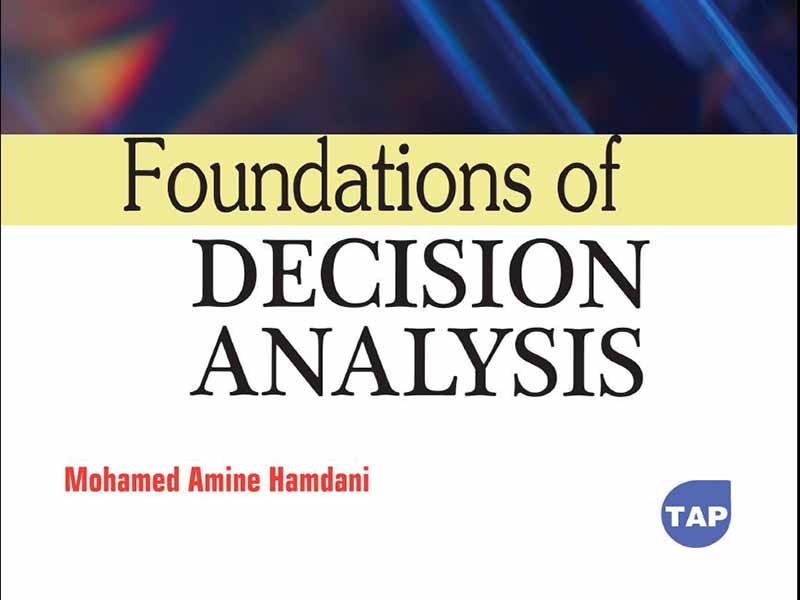- عنوان کتاب: Foundations of Decision Analysis
- نویسنده: Mohamed Amine Hamdani
- حوزه: تصمیم گیری
- سال انتشار: 2025
- تعداد صفحه: 224
- زبان اصلی: انگلیسی
- نوع فایل: pdf
- حجم فایل: 10.8 مگابایت
تحلیل تصمیم، رویکردی سیستماتیک و کمی به تصمیمگیری است که شامل ارزیابی و سنجش گزینههای مختلف برای تصمیمگیری آگاهانه میشود. مبانی تحلیل تصمیم در این شناخت نهفته است که تصمیمگیری اغلب پیچیده است و شامل عدم قطعیت، اهداف چندگانه و اولویتهای متناقض میشود. تحلیل تصمیم که به عنوان یک حوزه میانرشتهای برگرفته از اقتصاد، ریاضیات، روانشناسی و مدیریت توسعه یافته است، چارچوبی ساختارمند برای تحلیل تصمیمات به شیوهای منطقی و عقلانی ارائه میدهد. یکی از عناصر کلیدی، شناسایی معیارهای تصمیمگیری و کمیسازی عدم قطعیتها است که به تصمیمگیرندگان اجازه میدهد تا نتایج بالقوه انتخابهای مختلف را مدلسازی و ارزیابی کنند. درختهای تصمیمگیری، نمودارهای تأثیر و ارزیابی احتمالات، ابزارهای رایجی هستند که در تحلیل تصمیم برای نمایش و ارزیابی پیامدهای احتمالی تصمیمات استفاده میشوند. تحلیل تصمیم با تجزیه تصمیمات پیچیده به اجزای کوچکتر و قابل مدیریتتر، توانایی تصمیمگیرنده را در درک، مقایسه و در نهایت انتخاب مطلوبترین مسیر اقدام افزایش میدهد. این کتاب، «مبانی تحلیل تصمیم»، به هشت فصل تقسیم شده است که هر کدام بر جنبه خاصی از تحلیل تصمیم تمرکز دارند. قالب ساده، راهی سرراست برای خوانندگان فراهم میکند تا اصول اولیه این حوزه را بررسی و درک کنند. فصل اول تاریخچه تحلیل تصمیمگیری، معرفی پنج قانون و نشان دادن کاربرد آنها در دنیای واقعی را شرح میدهد. در فصل دوم، تمرکز بر نظریه تصمیمگیری است و به سوالات و فرآیندهای نظری میپردازد. این فصل مدلهای مختلف تصمیمگیری، مانند متوالی و غیر متوالی، را بررسی میکند و مفاهیمی مانند تصمیمگیری، ارزشگذاری و مطلوبیت مورد انتظار را پوشش میدهد. فصل سوم در مورد شناسایی مؤثر مسئله بحث میکند و طبقهبندیهایی را برای تحلیل تصمیمگیری معرفی میکند. فصل چهارم به بررسی تصمیمگیری در شرایط عدم قطعیت و ریسک میپردازد و ابزارهایی مانند درختهای تصمیمگیری و نمودارهای تأثیر را معرفی میکند. این فصل بینشهای عملی در مورد مدیریت موقعیتهای نامشخص ارائه میدهد. فصل پنجم به زمینه تصمیمگیری میپردازد و اهداف و معیارها را مورد بحث قرار میدهد. فصل ششم به بررسی تصمیمگیری با استفاده از نظریه بازیها، پوشش سناریوهای مختلف بازی و ارائه درک عملی از تعاملات استراتژیک میپردازد. فصل هفتم بر استراتژیهای ارتباطی مؤثر در تصمیمگیری تمرکز دارد. فصل آخر به نقش اخلاق در تصمیمگیری میپردازد و تمایزات و ملاحظات اخلاقی در درختهای تصمیمگیری را پوشش میدهد و بینشهایی را در مورد موقعیتهای اخلاقی دنیای واقعی ارائه میدهد. این کتاب که با تمرکز بر رفع نیازهای آموزشی دانشجویان و محققان طراحی شده است، قصد دارد دانش جامعی را ارائه دهد و درک عمیقی از تحلیل تصمیمگیری ایجاد کند. هدف ما این است که این کتاب به عنوان منبعی ارزشمند در رشتههای مختلف دانشگاهی مورد استفاده قرار گیرد و برای خوانندگانی که به دنبال پیمایش پیچیدگیهای سناریوهای تصمیمگیری هستند، وضوح و دیدگاههای روشنگرانهای ارائه دهد.
Decision analysis is a systematic and quantitative approach to decision-making that involves assessing and evaluating different alternatives to make informed choices. The foundations of decision analysis lie in the recognition that decision-making is often complex and involves uncertainty, multiple objectives, and conflicting priorities. Developed as an interdisciplinary field drawing from economics, mathematics, psychology, and management, decision analysis provides a structured framework to analyze decisions in a rational and logical manner. One key element is the identification of decision criteria and the quantification of uncertainties, allowing decision-makers to model and evaluate the potential outcomes of different choices. Decision trees, influence diagrams, and probability assessments are common tools used in decision analysis to represent and evaluate the possible consequences of decisions. By breaking down complex decisions into smaller, more manageable components, decision analysis enhances the decision-maker’s ability to understand, compare, and ultimately choose the most favorable course of action. This book, “Foundations of Decision Analysis,” is divided into eight chapters, each focusing on a specific aspect of decision analysis. The simple format provides a straightforward way for readers to explore and understand the basics of this field. The first chapter describes the history of decision analysis, introducing the Five Rules and illustrating their real-world application. In the second chapter, the focus is on decision theory, addressing theoretical questions and processes. The chapter explores different decision models, such as sequential and non-sequential, covering concepts like deciding, valuing, and expected utility. Chapter three discusses effective problem identification and introduces taxonomies for decision analysis. Chapter four explores decision-making under uncertainty and risk, introducing tools like decision trees and influence diagrams. It provides practical insights into handling uncertain situations. Chapter five delves into the decision context, discussing objectives and criteria. The sixth chapter explores decision-making using game theory, covering various game scenarios, and providing a practical understanding of strategic interactions. Chapter seven focuses on effective communication strategies in decision-making. The final chapter discusses the role of ethics in decision-making, covering ethical distinctions and considerations in decision trees, offering insights into real-world ethical situations. Designed with a focus on meeting the educational needs of students and scholars, this book aims to deliver comprehensive knowledge and foster a deep understanding of decision analysis. Our intention is for this book to serve as a valuable resource across various academic disciplines, providing clarity and insightful perspectives for readers seeking to navigate the complexities of decision-making scenarios.
این کتاب را میتوانید از لینک زیر بصورت رایگان دانلود کنید:
Download: Foundations of Decision Analysis



































نظرات کاربران